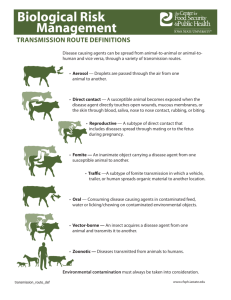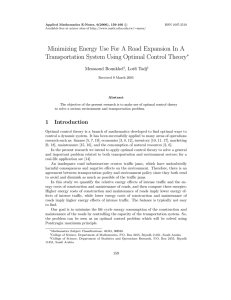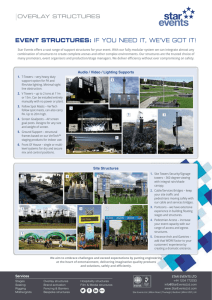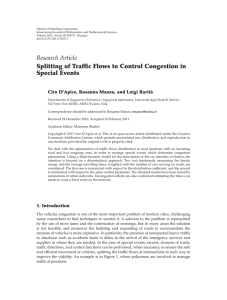Document 10851097
advertisement
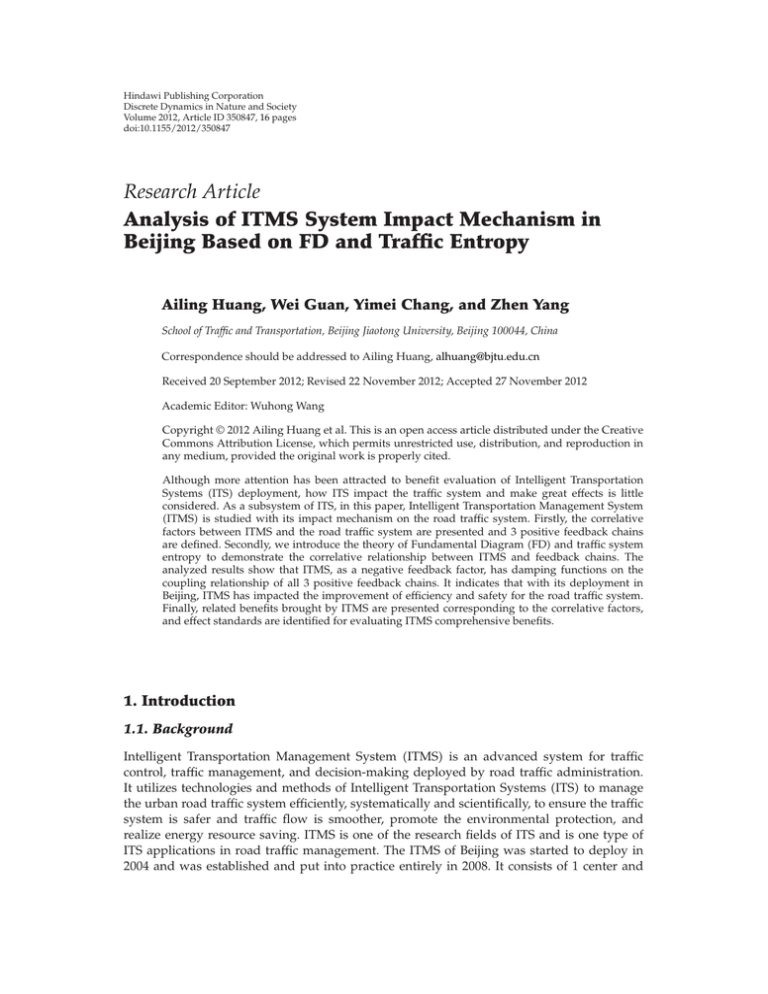
Hindawi Publishing Corporation
Discrete Dynamics in Nature and Society
Volume 2012, Article ID 350847, 16 pages
doi:10.1155/2012/350847
Research Article
Analysis of ITMS System Impact Mechanism in
Beijing Based on FD and Traffic Entropy
Ailing Huang, Wei Guan, Yimei Chang, and Zhen Yang
School of Traffic and Transportation, Beijing Jiaotong University, Beijing 100044, China
Correspondence should be addressed to Ailing Huang, alhuang@bjtu.edu.cn
Received 20 September 2012; Revised 22 November 2012; Accepted 27 November 2012
Academic Editor: Wuhong Wang
Copyright q 2012 Ailing Huang et al. This is an open access article distributed under the Creative
Commons Attribution License, which permits unrestricted use, distribution, and reproduction in
any medium, provided the original work is properly cited.
Although more attention has been attracted to benefit evaluation of Intelligent Transportation
Systems ITS deployment, how ITS impact the traffic system and make great effects is little
considered. As a subsystem of ITS, in this paper, Intelligent Transportation Management System
ITMS is studied with its impact mechanism on the road traffic system. Firstly, the correlative
factors between ITMS and the road traffic system are presented and 3 positive feedback chains
are defined. Secondly, we introduce the theory of Fundamental Diagram FD and traffic system
entropy to demonstrate the correlative relationship between ITMS and feedback chains. The
analyzed results show that ITMS, as a negative feedback factor, has damping functions on the
coupling relationship of all 3 positive feedback chains. It indicates that with its deployment in
Beijing, ITMS has impacted the improvement of efficiency and safety for the road traffic system.
Finally, related benefits brought by ITMS are presented corresponding to the correlative factors,
and effect standards are identified for evaluating ITMS comprehensive benefits.
1. Introduction
1.1. Background
Intelligent Transportation Management System ITMS is an advanced system for traffic
control, traffic management, and decision-making deployed by road traffic administration.
It utilizes technologies and methods of Intelligent Transportation Systems ITS to manage
the urban road traffic system efficiently, systematically and scientifically, to ensure the traffic
system is safer and traffic flow is smoother, promote the environmental protection, and
realize energy resource saving. ITMS is one of the research fields of ITS and is one type of
ITS applications in road traffic management. The ITMS of Beijing was started to deploy in
2004 and was established and put into practice entirely in 2008. It consists of 1 center and
2
Discrete Dynamics in Nature and Society
Facility Emergency
plan
system
Information Dissemination
Platform
Telecommunication safety
Digital legalization system
Platform
Bus
Van
Integrated information system
Road
Integrated Operation
Traffic monitor system
Traffic signal control system
Traffic command system
Dispatch and Command
Platform
Fine
Traffic organization system
Driver Accident Violation
Traffic guidance system
Car
.
.
.
Intelligent Transportation Management System
ITMS Standards and Regulations
Figure 1: Architecture of ITMS in Beijing.
3 platforms, including the Traffic Management Data Center, the Dispatch and Command
Platform, the Integrated Operation Platform, and the Information Dissemination Platform
shown in Figure 1. Based on these center and platforms, 8 related informationized support
systems and 99 application subsystems are integrated and developed to mainly function
on command and dispatch, traffic signal control, comprehensive supervision, informationprovided service, and so forth. With its deployment within the 5th Ring Road in Beijing, the
traffic congestion has been alleviated effectively, and some benefits have appeared, such as
enhancing traffic capacity, improving service level and road safety, increasing the response to
traffic accidents, and reducing environmental pollution. Therefore, more attention has been
attracted to study the impacts of ITMS application in Beijing.
1.2. Related Works
The analysis of ITS impact has been a subject of interest for many years; however, the
literature mainly emphasized on evaluating ITS benefits qualitatively or quantitatively. On
evaluation methods and procedures, in 1, the authors proposed that physical logical
structure, market cost, and information interaction structure should be established according to subsystems of ITS, so as to explain the relationship between ITS and estimate socioeconomic benefits. Haynes and Li 2 introduced the Probabilistic Multidimensional Scaling
Algorithm to evaluate the questionnaires and deploy the subsystems of ITS. The method
of Multicriteria Analysis was also applied in ITS impacts evaluation 3. Both cost-benefit
analysis and data envelopment analysis DEA 4, one type of multicriteria appraisals,
Discrete Dynamics in Nature and Society
3
were applied to analyze the socioeconomic impact of convoy driving systems. A computable
general equilibrium CGE model was put forward to analyze the impact of ITS on Japan’s
economy 5. In addition, a simulation was used to assess the impacts of ITS on the traffic
system 6, 7. Dotoli et al. 8 provided a modeling approach by Petri nets to analyze the
impact of Information and Communication Technologies ICT on real-time management
and operation, as well as the impact on the infrastructures of intermodal transportation systems. Wang et al. 9, 10 brought forward a methodology for model-based digital driving
dependability analysis in ITS, which represents an activity in the direction of safety assessment to ITS and gives a new idea how to model digital driving reliability and safety.
Recently, Cantarella 11 presented a day-to-day dynamic model, whose application shows
that this proposed approach can be applied to model the effect of ITS based both on the value
of user surplus and its stability over time.
On ITS impacts and benefits, existing researches such as 12–16 mainly focused on
the quantitative evaluation of ITS socioeconomic benefits, and some focused on safety, for
example, 7, 17, 18. Farooq et al. 19 pointed out that ITS affect not only the transportation
industry, but also other industries with a quantitative economic analysis through a Leontief’s
Input-Output I-O model 20. The comprehensive effects, including the environmental and
safety benefits, have also been considered in related researches, for example, 21–23.
These efforts have been limited in what ITS effects are and how to evaluate them,
but did not refer to how ITS impact the traffic system and why they make effects. Although
Newman-Askins et al. 24 pointed out that there was presently little understanding of the
causal relationships between ITS projects and their impacts and often it may not be appropriate to transfer results in space and time, they only provided a state-of-practice summary
of ITS evaluation methods and impact measurement efforts, without quantitative analysis of
the relationship and impact mechanism.
1.3. Motivation and Contribution
To evaluate the influences of ITMS in Beijing comprehensively, it’s necessary to identify the
impact mechanism of ITMS on the road traffic system, and then define the evaluation content
and evaluation system of ITMS effects. The paper is organized as follows. In the next section,
we discuss the correlative factors between ITMS and the road traffic system and present 3
positive feedback chains by systemic dynamics theory. In Section 3, according to correlative
factors, the intrinsic impact mechanism of ITMS on the road traffic system is studied based
on 3 positive feedback chains, respectively. Firstly, the ITMS impact mechanism on travel
velocity is illuminated through the Fundamental Diagram FD theory. Then with the entropy
theory of traffic system, the ITMS impacts on the disequilibrium of road network load and
traffic accidents are investigated. Consequently, in terms of the impact mechanism, the effects
and benefits brought by ITMS are identified and related evaluation standards are defined
in Section 4, which will lay the pretheoretical basis for comprehensive evaluation of ITMS
system benefits. Conclusions and an outlook are given in Section 5.
2. Correlative Factors between ITMS and Road Traffic System
It is known that with socioeconomic acceleration of urban development, the vehicle
maintenance number increases rapidly and various types of traffic demands expand greatly.
Those factors have resulted in the increase of road traffic flow and decrease in traveling speed,
4
Discrete Dynamics in Nature and Society
Increase in traffic
accidents (∆A)
+
Increase in
Increase in motor
quantity of traffic
vehicle number
+
(∆N)
flow (∆Q)
+
Decrease in
+
travel velocity
(∆V )
+
Increase in
disequilibrium of
network load (∆E)
Figure 2: Correlation framework of traffic systematic factors.
and then boosted the occurrence of traffic accidents and enhanced the disequilibrium of road
network load. Conversely, the increase of traffic accidents and disequilibrium of network load
further impact the decline of traveling speed. We take these factors into consideration and
analyze their interactions by the theory of system dynamics. Then we can obtain 3 positive
feedback chains as follows:
1 the growth in motor vehicle number ΔN → the increase in quantity of traffic
flow ΔQ → the decrease in travel velocity ΔV ,
2 the growth in motor vehicle number ΔN → the increase in quantity of traffic
flow ΔQ → the increase in disequilibrium of network load ΔE → the decrease
in travel velocity ΔV ,
3 the growth in motor vehicle number ΔN → the increase in quantity of traffic flow
ΔQ → the increase in traffic accidents ΔA → the decrease in travel velocity
ΔV .
The correlation and interaction between above factors in detail is shown in Figure 2.
Based on above analysis, we introduce the ITMS system into this correlation framework to study its influence. There is no doubt that the deployment of ITMS will exert significant influences on controlling the traveling speed, reducing traffic accidents, and decreasing
the disequilibrium of road network load. In all 3 positive feedback chains, ITMS plays a role
of negative feedback factor as shown in Figure 3.
According to the ITMS impact mechanism described in Figure 3, we will collect the
urban road traffic-related data of Beijing to analyze these 3 feedback chains in the next section.
3. Impact Mechanisms of ITMS on Road Traffic System
3.1. Positive Feedback Chain: ΔN → ΔQ → ΔV
We introduce the ITMS impact into the feedback chain ΔN → ΔQ → ΔV , as shown in
Figure 4. As a negative feedback factor, we can find that ITMS plays a role to restrain the
decrease of traveling speed.
Discrete Dynamics in Nature and Society
5
Increase in
traffic accidents
(∆A)
−
Increase in
rapid response
capacity (∆R)
−
+
ITMS
+
Increase in
Increase in
quantity of
motor vehicle
number (∆N) + traffic flow (∆Q)
−
+
+
Decrease in
travel velocity
(∆V )
+
+
−
Increase in
disequilibrium of
network load (∆E)
Figure 3: Correlation framework of traffic systematic factors with introducing ITMS as a negative feedback
factor.
ITMS
Increase in
motor vehicle
number (∆N)
+
Increase in
quantity of
traffic flow
(∆Q)
−
+
Decrease in
travel velocity
(∆V )
Figure 4: The positive feedback chain ΔN → ΔQ → ΔV with the ITMS impact.
In order to study further the impact of ITMS on the urban traffic system, we will
analyze the changes in traffic flow and speed against the growth of motor vehicles.
According to Figure 5, it is found that although the motor vehicle number increases
rapidly from the year of 2000 to 2010 in Beijing, the growth rate of traffic flow does not
maintain consistent with the rate of motor vehicle increase correspondingly. In particular,
we can observe that since 2004 when ITMS was begun to deploy in large scale, in spite of the
rapid increase in vehicle number, the growth rate of traffic flow was slowing gradually, and
there was an obvious decrease in 2008 when Beijing held the Olympic Games. In addition, the
decline rate of ring roads’ average velocity did not keep pace with the increase rate of motor
vehicle. Since 2004, the decline rate of average velocity was also slowing down. Although in
2007 the average velocity of ring roads dropped to the minimum in recent years, in 2008, it
began to rebound and was increasing with ITMS being put into practice in a row.
To explain this phenomenon further, based on the traffic data collected from ring roads
of Beijing, we use the FD theory to describe the relationship between travel velocity and
traffic flow shown in Figure 6. According to the forecast by the FD theoretical curve, once
traffic flow quantity reaches the saturation value, there will be a sudden drop in average
velocity; however, in terms of the real data in Beijing’s ring roads, we find that after traffic
flow quantity reaches the saturation value of 1,800 veh/h, there is no sudden drop in average
6
Discrete Dynamics in Nature and Society
450
400
350
300
250
200
150
100
50
0
70
60
50
40
30
20
10
2000 2001 2002 2003 2004 2005 2006 2007 2008 2009 2010
0
Motor vehicle (ten thousand)
Traffic flow (ten thousand)
Average velocity of the ring roads (km/h)
Figure 5: The development trends of motor vehicle maintenance number of Beijing, average traffic flow,
and average travel velocity of the 2nd, 3rd, and 4th Ring Roads in Beijing from the year of 2000 to 2010.
Fundamental
Diagram
Velocity (km/h)
80
Velocity
maintaining
phenomenon
60
40
20
0
0
600
1200
1800
2400
Traffic flow (veh/h)
Figure 6: Microcosmic data denoted by “◦ ” of average traffic flow and velocity of the 2nd, 3rd, and 4th
Ring Roads in Beijing.
velocity, but there is maintaining in a certain range, which we call it velocity maintaining
phenomenon.
Likewise, we analyze the relationship between average traffic flow and vehicle density
shown in Figure 7. We also find that when the density of vehicles reaches 100 veh/km
saturation value, the real traffic flow in Beijing does not decline as rapidly as what is predicted
by the FD theory, but is maintaining in a certain range, which we call it flow rate maintaining
phenomenon.
Based on above empirical analysis of Figures 4, 5, and 6, abstractly, we can consider
that ITMS, as a negative feedback factor, has a damping function on the coupling relationship
of positive feedback chain ΔN → ΔQ → ΔV . To describe this damping function, we put
forward the concepts of speed maintaining capability and flow rate maintaining capability. The
definitions are identified as follows.
3.1.1. Speed Maintaining Capability Cv
Speed maintaining capability Cv means below the critical speed of saturated traffic flow, a
rate of traffic flow samples that are with velocity maintaining phenomenon on the overall
Discrete Dynamics in Nature and Society
7
Flow rate
maintaining
Traffic flow (veh/h)
2000
phenomenon
1500
1000
Fundamental
Diagram
500
0
0
50
100
Density of vehicles (veh/km)
Figure 7: Microcosmic data denoted by “◦ ” of average traffic flow and vehicle density of the 2nd, 3rd,
and 4th Ring Roads in Beijing.
population. It indicates how much traffic flow can maintain in a certain velocity range
without a sudden drop after traffic flow quantity reaches the saturation value. Cv is demonstrated as
n v, q v∈vc −Δv,vc × 100%,
Cv N v, q 3.1
v≤vc
where vc : v|qqmax is the critical speed when traffic flow quantity q qmax . Here, vc , qmax can be
defined by a approach presented by one of our authors—Guan and He 25; Δv demonstrates
the increment of velocity; nv, q is the sample size of traffic flow when v ∈ vc − Δv, vc ;
Nv, q is the overall population when v ≤ vc .
3.1.2. Flow Rate Maintaining Capability Cq
Flow rate maintaining capability Cq is a rate of the traffic flow samples with flow rate
maintaining phenomenon on the overall population over vehicle critical density. It reflects
a degree which the quantity of traffic flow can maintain in a certain flow rate range without
a sudden drop since the density of vehicles is larger than the saturation value. Cq is demonstrated as
n q, ρ ρ≥ρc ,q∈qmax −Δq,qmax × 100%,
Cq N q, ρ ρ≥ρc
3.2
where ρc : ρ|qqmax is the critical density when traffic flow quantity q qmax . Here, ρc can be
defined by 25; Δq demonstrates the traffic flow increment of volume; nq, ρ is the sample
size when vehicle density ρ ≥ ρc and traffic flow quantity q ∈ qmax − Δq, qmax ; Nq, ρ is the
overall population when ρ ≥ ρc .
In the rest of this section, we will calculate Cv and Cq by above equations, based
on the traffic flow data of the 2nd, 3rd, and 4th Ring Roads that are collected by Remote
Discrete Dynamics in Nature and Society
Average daily flow (ten thousand)
8
Regression curve
360
340
320
300
280
260
240
220
200
180
200
220
240
260
280
300
320
340
360
380
Motor vehicles (ten thousand)
Figure 8: Linearity correlation between motor vehicle number and traffic flow quantity in Beijing.
Traffic Microwave Sensors RTMS set up in Beijing, and make an analysis for the computing
results. Before computing Cv and Cq , the data outliers have been preprocessed in advance
with a method that is presented by Guan and He 26. Here, the impacts by changes of roads’
condition are not considered.
Firstly, through the regression analysis, it is not difficult to find that the two parameters
of vehicle number and traffic flow quantity are highly coupled, and the correlation coefficient
is 0.96 shown in Figure 8, which indicates that each vehicle in Beijing has nearly traveled
one trip on the 2nd, 3rd, or 4th Ring Road every day on average.
Secondly, according to the phase identification of traffic flow on urban freeways 25 in
Beijing, we can define qmax 2000 veh/h and then vc is 40 km/h. Thus, when vc 40 km/h,
the speed maintaining capability Cv of ring roads is calculated as follows:
i when Δv 5 km/h, Cv 17.0%;
ii when Δv 10 km/h, Cv 45.3%;
iii when Δv 15 km/h, Cv 90.6%.
This means, for example, after the flow rate reaches its maximum value qmax 2000 veh/h, the sample data whose speed is between 25 km/h to 40 km/h account for nearly
90% of total population. It reflects that more than 90% of traffic flow still can travel quite
smoothly without a sudden transform to stop status after traffic flow quantity reaches the
saturation value.
Thirdly, when ρc 50 veh/km qmax 2000 veh/h, the traffic flow maintaining capability Cq of ring roads are as follows:
i when Δq 500 veh/km, Cq 47.0%;
ii when Δq 800 veh/km, Cq 83.1%.
This means that when the density is larger than the critical density ρc 50 veh/km,
the sample data whose flow rate is between 1500 veh/h to 2000 veh/h account for 47% of
total population, and the sample data whose flow rate is between 1200 veh/h to 2000 veh/h
account for 83% of total population. The computing results show that although the density is
over the critical value, quite large numbers of traffic flow can maintain in a certain flow rate
range without a sudden drop.
Discrete Dynamics in Nature and Society
9
ITMS
Increase in motor
vehicle number
(∆N)
+
Increase in
quantity of
traffic flow (∆Q)
Decrease in
travel velocity
(∆V )
+
+
−
Increase in
disequilibrium of
network load (∆E)
Figure 9: The Positive feedback chain ΔN → ΔQ → ΔE → ΔV with the ITMS impact.
Consequently, we can draw a conclusion that ITMS, as a negative feedback factor, has
a damping function on the coupling relationship in positive feedback chain ΔN → ΔQ →
ΔV .
3.2. Positive Feedback Chain: ΔN → ΔQ → ΔE → ΔV
In the positive feedback chain ΔN → ΔQ → ΔE → ΔV , we also introduce the ITMS factor
shown in Figure 9.
Similarly, we need to study the effect and nature of ITMS on the coupling relationship
in the positive feedback chain ΔN → ΔQ → ΔE → ΔV . Here, the entropy of the system
science theory will be introduced to analyze ITMS impact on this positive feedback chain as
follows.
The entropy is a state function to indicate the rate of absorbed heat on temperature for
material during a reversible process by Rudolf Clausius in 1865. It is a parameter used to
reflect the disorder degree for a system. The larger the entropy is, the more chaotic a system
would be. The entropy ds of an open system consists of two parts: one is the entropy increase
called entropy production di s that is caused by a irreversible process within the system itself;
the other is the entropy exchange called entropy flow de s that is caused by exchanging the
energy and substance between the system and the outside. The total entropy change ds of an
opened system is the sum of entropy production and entropy flow, that is,
ds di s de s.
3.3
In the research field of traffic flow, the entropy theory has been introduced to
investigate the traffic systematic characteristics and applied in different cases. For example,
on modeling research, the traffic system model based on thermodynamics entropy was
constructed to reflect the traffic conditions in 27. Karmakar and Majumder 28 presented
the entropy maximization technique to maximize the flow rate at a given continuous traffic
stream, so as to illustrate the flow-concentration relationship. Furthermore, Li et al. 29
considered that trip distribution problems can be modeled as entropy maximization models
with quadratic cost constraints, then they proposed an entropy maximization model with
10
Discrete Dynamics in Nature and Society
chance constraint and proved it is convex. Lu et al. 30 constructed the entropy solutions
for the Lighthill-Whitham-Richards LWR traffic flow model with a piecewise quadratic
flow-density relationship, which may be used for predicting traffic or as a diagnosing tool
to test the performance of numerical schemes. One of latest researches on entropy is that
an entropy space method is based on a 3D-space built on a flow-packet level by VelardeAlvarado et al. 31. And they modeled the network traffic by using Gaussian Mixtures and
Extreme Generalized Distributions. By integrating this model in an Anomaly-Based Intrusion
Detection System, anomalous behavior traffic can be detected easily and early. Ngoduy
and Maher 32 put forward an effort to find global optimal parameters of a second order
macroscopic traffic model using a cross entropy method. On entropy-based applications on
traffic system, Montemayor-Aldrete et al. 33 introduced a new concept of the production
rate of entropy due to traffic flow. With the use of such a concept, the percentage of increase
in the fuel consumption rate due to velocity fluctuations on the traffic flow can be easily
determined. Tapiador et al. 34 provided a new measure of Intermodal Entropy to help to
characterize high speed train stations HSTS and improve their intermodal performance.
This variable can also be integrated into models of regional accessibility to take into account
the intermodality of HSTS within a single comprehensive estimate. Murat et al. 35 used
Shannon Entropy Approach to deal with the determination of black spots’ traffic safety levels.
In addition, the entropy was applied in traffic assignment problems in 29, 36, 37 and the
cross entropy method was used to optimize signal 38. Chi et al. 39 assumed that each cell
of the transportation subnetwork O-D flow table contains an elastic demand function and
then proposed a combined maximum entropy-least squares ME-LS estimator, by which OD flows are distributed over the subnetwork so as to maximize the trip distribution entropy,
while demand function parameters are estimated for achieving the least sum of squared
estimation errors. Although the above entropy-based methods and models are different in
different studies, they all show that the essence of entropy could be used to reflect a system’s
characteristics as an effective approach.
Here, based on the dissipative structure theory, we assess the disequilibrium of road
network load in terms of the changes in order degree of an open traffic system by value of
system entropy 40.
1 If ds > 0, it shows that traffic system entropy has an increase and the order degree
of system will decrease, so it indicates the disequilibrium of road network load will
boost;
2 If ds < 0, it reflects that the external environment has provided negative entropy flow
to the system, and if de s < −di s, the system entropy has a decrease and order degree
will increase, so it means the disequilibrium of road network load will decrease;
3 If ds 0, it indicates that the order degree of system, that is, the disequilibrium of
road network load, is essentially invariable.
In order to calculate the value of entropy in a traffic system, the following will introduce the definition of information. Information is a measure to the degree of uncertainty for
a system. For a given random variable X, the probability of the event xi is pxi , then the
self-information Ixi of the event xi is defined as, 41,
Ixi −C log10 pxi ,
where C is a constant.
xi ∈ X,
3.4
Discrete Dynamics in Nature and Society
4 Jishuitan Bridge
3 Zhonglou Northbridge 2 Andingmen Bridge
2058
2067
2060
2065
2057
2059
2061 2062
2056
2063 2064 2066
2055
82 Deshengmen Bridge
2003
2054
5 Xizhimen Bridge
6 Guanyuan Bridge
2052
2050
7 Fuchengmen Bridge
11 Xibianmen Bridge
2042
2041
2040
2039
2038
2037
2036
13 Guanganmen Bridge
2035
2034
24 Dongsishitiao Bridge
23 Chaoyangmen Bridge
2008
2009
2045
2044
2043
2010
2011
2012
2013
2014
2015
2018
96 Kaiyang Bridge 16 Yongdingmen Bridge
2033 2032
2031
2030 2029 2028
15 Youanmen
Bridge
2024
2026
2027
14 Caihuying Bridge
2004
2007
2049
2047
2046
2001
2002
1 Dongzhimen Bridge
2006
2048
9 Yuetan Southbridge
12 Tianningsi Bridge
2005
2053
2051
8 Yuetan Northbridge
10 Fuxingmen
11
2025
17 Yuting
Bridge
16 Taoran
Bridge
2020
2022
22 Jianguomen Bridge
21 Dongbianmen Bridge
20 Guangqumen Bridge
2016
2017
19 Guangming Bridge
2019
2021
2023
18 Zuoanmen
Bridge
Figure 10: The 2nd Ring Road in Beijing marked with 24 sections.
In 1948, Claude Elwood Shannon introduced the entropy into the concept of information.
And the entropy Hx of a discrete random variable X is identified as
Hx −C
n
pxi log10 pxi ,
3.5
i1
where C is a constant.
It can be found that the entropy is a statistical probability-weighted average of selfinformation in terms of 3.4 and 3.5. The self-information Ixi and entropy Hx are the
functions of probability and unrelated to the value of the variables.
According to the above definitions, we use the concept of traffic entropy to estimate the
disequilibrium of road network load. The traffic entropy Et is demonstrated as, 42,
Et −C
n
ki · pi · log10 pi ,
3.6
i1
where Et is the entropy of a road traffic system, and C is a constant; ki is the weight of the
road section i, ni1 ki 1; pi {Δλi / ni1 Δλi , i 1, 2, 3, . . . , n} is distribution of congestion
deviation 9, ni1 pi 1; Δλi max{λi − 0.8, 0} is congestion deviation of the road section i;
λi denotes the average congestion degree, and it is a rate of traffic flow on capacity in section
i; and λ 0.8 is threshold of congestion.
Then we will illustrate the meaning of traffic entropy by calculating entropy of the 2nd
Ring Road of Beijing in 2004 and 2008, respectively. The 2nd Ring Road shown in Figure 10 is
marked with 24 sections, that is, i 1, 2, . . . , 24.
12
Discrete Dynamics in Nature and Society
0.35
0.2573
0.2554
Traffic entropy
0.3
0.25
0.2
0.15
0.1
0.05
0
2004
2008
Figure 11: Traffic entropies of the 2nd Ring Road in 2004 and 2008 in Beijing.
Increase in
traffic accidents
(∆A)
−
+
Increase in
Increase in
quantity of
motor vehicle
+
+
number (∆N)
traffic flow (∆Q)
ITMS
+
Decrease in
travel
velocity (∆V )
Figure 12: The positive feedback chain ΔN → ΔQ → ΔA → ΔV with the ITMS impact.
Based on the empirical data, we estimate the traffic entropies of the 2nd Ring Road in
2004 and 2008 by 3.5. The comparison of these two entropies is shown in Figure 11.
Figure 11 shows that the traffic entropy of 2008 does not increase, but decrease slightly
comparing with that of 2004, which means that the order degree has increased and the
disequilibrium of road network load decreased despite the rapid growth in vehicle number.
Therefore, we can get a conclusion that ITMS, as a negative feedback factor, has a damping
function on the coupling relationship of positive feedback chain ΔN → ΔQ → ΔE → ΔV .
3.3. Positive Feedback Chain ΔN → ΔQ → ΔA → ΔV
In the same way, we introduce the ITMS impact into the positive feedback chain ΔN →
ΔQ → ΔA → ΔV , which is shown in Figure 12.
In terms of the statistic date, the number of traffic accidents in 2008 has decreased from
5,425 to 1,960 comparing with that of 2004 shown in Figure 13, with the decreased accidents
accounting for about 62.03% of 2004; while the number of vehicles is growing increasingly,
the total length of road has extended from 4,064 km to 6,186 km and the total area of road
from 64.17 million m2 to 89.40 million m2 . It indicates that the safety of urban traffic system
has been improved with ITMS deployment and application. So we can draw a conclusion
Discrete Dynamics in Nature and Society
13
5425
Traffic accidents
6000
5000
4000
1960
3000
2000
1000
0
2004
2008
Figure 13: Comparison of traffic accidents number between 2004 and 2008 in Beijing.
that ITMS has a damping function on the coupling relationship of positive feedback chain
ΔN → ΔQ → ΔA → ΔV as a negative feedback factor.
4. Benefits and Evaluation Standard of ITMS on Road Traffic System
Based on above analysis, it can get a conclusion that with the deployment of ITMS in Beijing,
the negative influence on traveling speed, road traffic safety, and the disequilibrium of
network load aroused by the increase of traffic flow have been weakened efficiently. ITMS has
effects on improving road traffic efficiency, alleviating traffic congestion, and enhancing road
service capacity. According to the impact mechanism, the benefits brought by ITMS can be
concluded in 4 aspects: socioeconomic benefit, energy resource and environmental benefits,
traffic safety, and management efficiency.
For each benefit aspect, we identify standards for evaluating benefits of ITMS. The
evaluation standards of socioeconomic benefit can be mostly derived from the increase of
travel velocity, mainly including 1 reduction in vehicles’ operational cost, 2 reducing
traveling time, and 3 investment reduction on land resource and transportation infrastructure shown in Figure 14. And the standards of energy resources and environmental
benefits consist of 1 decrease in traffic noise, 2 decrease in vehicle tailpipe emission,
3 greenhouse gas emission, 4 reduction of energy resource, and 5 improvement on
consumption structure of energy resource, which are also brought mainly because of the
increase in travel velocity shown in Figure 14.
For evaluation standards of traffic safety benefits, because of the decrease in traffic
accidents and improvement on vehicle safety, they can be denoted by 1 reduction in vehicle
loss, 2 loss of vehicle stolen or robbed, 3 decrease in loss of personal casualty, and 4
loss of social public institution service shown in Figure 15. The management efficiency for
road administrations can be indicated by the increase in response time for alarm shown in
Figure 15.
5. Conclusion
Summing up, in this paper, in order to investigate the ITMS impacts on road traffic system,
we have introduced 3 positive feedback chains to analyze the correlative factors between
14
Discrete Dynamics in Nature and Society
Decrease
in traffic
noise
Decrease in
vehicle tailpipe
emission
+
+
ITMS
Decrease in
greenhouse
gas emission
+
Alleviating
in travel
velocity
decrease
+
+
Reduction in
vehicles’ operational
cost
+
Benefit of reducing
traveling time
+
+
+
Reduction
of energy
resource
Investment reduction
on land resource and
transportation
infrastructure
Improvement on
energy resource
consumption structure
Figure 14: Benefits of social economy, energy resource and environment, and related evaluation standards.
+
Enhancement
of rapid
response
capacity
+
+
ITMS
+
Decrease in
traffic
accidents
+
+
+
Improvement
on vehicle
safety
+
Increase in response
time for alarm
Reduction in vehicle
loss
Decrease in loss of
personal casualty
Decrease in loss of
social public institution
service
Reduction in loss of
vehicle stolen or robbed
Figure 15: Benefits of traffic safety and management efficiency and related evaluation standards.
ITMS and road traffic system. The results show that ITMS has damping functions on the
coupling relationship of 3 positive feedback chains ΔN → ΔQ → ΔV , ΔN → ΔQ →
ΔE → ΔV , and ΔN → ΔQ → ΔA → ΔV as a negative feedback factor. This indicates
that with its deployment in Beijing, ITMS has impacted significantly the improvement on
road traffic efficiency, alleviation of traffic congestion, and enhancement of road service
capacity. Accordingly, in terms of this impact mechanism, the benefits of ITMS deployment
have been presented and related evaluation standards are identified, which provides a
comprehensive evaluation framework for subsystems of ITS. Such analyses would provide
richer information for ITS benefits evaluation. Indeed, some policy factors, such as traffic
regulation and limitation of vehicle use during period of 2008 Olympic Games, are not taken
in account to analyze the impact mechanism. But our paper present an approach to study
the ITS impacts from a new view point. Given more data, future work would focus on
considering the above policy factors and quantifying the impact benefits.
Discrete Dynamics in Nature and Society
15
Acknowledgments
This research is supported by the Major State Basic Research Development Program of China
973 Program Grant no. 2012CB725403-5, the Key Program of National Natural Science
Foundation of China Grant no. 71131001-2, and the Fundamental Research Funds for the
Central Universities of China Approval no. 2011JBM062.
References
1 H. Lo, M. Hickman, and S. Weissenberger, “Structured approach for ITS architecture representation
and evaluation,” in Proceedings of the 6th Vehicle Navigation and Information Systems Conference, pp.
442–449, August 1995.
2 K. E. Haynes and M. Li, “Analytical alternatives in intelligent transportation system ITS evaluation,” Research in Transportation Economics, vol. 8, pp. 127–149, 2004.
3 K. D. Brucker, A. Verbeke, and C. Macharis, “The application of multicriteria -analysis to the evaluation of intelligent transport systems,” Research in Transportation Economics, vol. 8, pp. 151–179, 2004.
4 Z.-C. Juan, J.-P. Wu, and M. McDonald, “Socio-economic impact assessment of intelligent transport
systems,” Tsinghua Science and Technology, vol. 11, no. 3, pp. 339–350, 2006.
5 T. Kawakami, P. Tiwari, and M. Doi, “Assessing impact of ITS on Japan’s economy using a computable
model,” Research in Transportation Economics, vol. 8, pp. 525–547, 2004.
6 H. Liu, L. Chu, and W. Recker, “Performance evaluation of ITS strategies using microscopic simulation,” in Proceedings of the 7th International IEEE Conference on Intelligent Transportation Systems (ITSC
’04), pp. 917–921, Washington, DC, USA, October 2004.
7 M. Vanderschuren, “Safety improvements through Intelligent Transport Systems: a South African
case study based on microscopic simulation modelling,” Accident Analysis and Prevention, vol. 40, no.
2, pp. 807–817, 2008.
8 M. Dotoli, M. P. Fanti, A. M. Mangini, G. Stecco, and W. Ukovich, “The impact of ICT on intermodal
transportation systems: a modelling approach by Petri nets,” Control Engineering Practice, vol. 18, no.
8, pp. 893–903, 2010.
9 W.-H. Wang, H.-W. Guo, H. Bubb, and K. Ikeuchi, “Numerical simulation and analysis procedure for
model-based digital driving dependability in intelligent transport system,” KSCE Journal of Civil Engineering, vol. 15, no. 5, pp. 891–898, 2011.
10 W.-H. Wang, Vehicle’s Man-Machine Interaction Safety and Driver Assistance, China Communications
Press, Beijing, China, 2012.
11 G. E. Cantarella, “Day-to-day dynamic models for intelligent transportation systems design and
appraisal,” Transportation Research Part C. In press.
12 L. K. Pekka and L. H. Jukka, “Profitability evaluation of intelligent transport system investments,”
Journal of Transportation Engineering, vol. 128, no. 3, pp. 276–286, 2002.
13 Y. J. Nakanishi and J. C. Falcocchio, “Performance assessment of intelligent transportation systems
using data envelopment analysis,” Research in Transportation Economics, vol. 8, pp. 181–197, 2004.
14 T. Moore and R. Pozdena, “Framework for an economic evaluation of transportation investments,”
Research in Transportation Economics, vol. 8, pp. 17–45, 2004.
15 A. Stevens, “The application and limitations of cost-benefit assessment CBA for intelligent transport
systems,” Research in Transportation Economics, vol. 8, pp. 91–111, 2004.
16 W. Chris and M. Mahmoud, “Transportation benefit-cost analysis: lessons from CAL-B/C,” in Proceedings of the 87th Annual Meeting of Transportation Research Board, pp. 79–87, Washington, DC, USA,
2004.
17 T. Vaa, M. Penttinen, and I. Spyropoulou, “Intelligent transport systems and effects on road traffic
accidents: state of the art,” IET Intelligent Transport Systems, vol. 1, no. 2, pp. 81–88, 2007.
18 R. Kulmala, “Ex-ante assessment of the safety effects of intelligent transport systems,” Accident Analysis and Prevention, vol. 42, no. 4, pp. 1359–1369, 2010.
19 U. Farooq, M. A. Siddiqui, L. Gao, and J. L. Hardy, “Intelligent transportation systems: an impact
analysis for michigan,” Journal of Advanced Transportation, vol. 46, pp. 12–25, 2012.
20 W. Leontief, “Quantitative input and output relations in the econometric system of the United States,”
The Review of Economic Statistics, vol. 18, pp. 105–125, 1936.
21 B. J. Kanninen, “Intelligent transportation systems: an economic and environmental policy
assessment,” Transportation Research A, vol. 30, no. 1, pp. 1–10, 1996.
16
Discrete Dynamics in Nature and Society
22 J.-C. Thill, G. Rogova, and J. Yan, “Evaluating benefits and costs of intelligent transportation systems
elements from a planning perspective,” Research in Transportation Economics, vol. 8, pp. 571–603, 2004.
23 F. Shi, J. Lu, and W. Wang, “Method of benefits evaluation for urban traffic command center and its
application,” Computer and Communications, vol. 22, no. 2, pp. 43–46, 2004.
24 R. Newman-Askins, L. Ferreira, and J. Bunker, “Intelligent transport systems evaluation: from theory
to practice,” in Proceedings of the 21st ARRB and 11th REAAA Conference, Transport Our Highway to a
Sustainable Future, pp. 1011–1026, May 2003.
25 W. Guan and S.-Y. He, “Statistical features and phase identification of traffic flow on urban freeway,”
Journal of Transportation Systems Engineering and Information Technology, vol. 7, no. 5, pp. 42–50, 2007.
26 W. Guan and S.-Y. He, “Statistical features of traffic flow on urban freeways,” Physica A, vol. 387, no.
4, pp. 944–954, 2008.
27 C.-Y. Sheng, Y.-L. Pei, and L.-N. Wu, “Traffic entropy characteristics at on-ramp junctions on urban
freeway,” Journal of Jilin University, vol. 37, no. 6, pp. 1273–1277, 2007.
28 K. Karmakar and S. K. Majumder, “Maximum entropy approach in a traffic stream,” Applied Mathematics and Computation, vol. 195, no. 1, pp. 61–65, 2008.
29 X. Li, Z.-F. Qin, L.-X. Yang, and K.-P. Li, “Entropy maximization model for the trip distribution
problem with fuzzy and random parameters,” Journal of Computational and Applied Mathematics, vol.
235, no. 8, pp. 1906–1913, 2011.
30 Y.-D. Lu, S. Wong, M.-P. Zhang, C.-W. Shu, and W.-Q. Chen, “Explicit construction of entropy
solutions for the lighthill-whitham-richards traffic flow model with a piecewise quadratic flow—
density relationship,” Transportation Research B, vol. 42, pp. 355–372, 2008.
31 P. Velarde-Alvarado, A. F. Martı́nez-Herrera, and A. Iriarte-Solis, “Using entropy spaces and mixtures
of gaussian distributions to characterize traffic anomalies,” Procedia Technology, vol. 3, pp. 97–108,
2012.
32 D. Ngoduy and M. J. Maher, “Calibration of second order traffic models using continuous cross
entropy method,” Transportation Research C, vol. 24, pp. 102–121, 2012.
33 J. A. Montemayor-Aldrete, P. Ugalde-Vélez, M. D. Castillo-Mussot, C. A. Vázquez-Villanueva, G.
J. Vázquez, and A. Mendoza-Allende, “Steady state traffic flow, entropy production rate, temporal
fluctuations and fuel consumption,” Physica A, vol. 361, no. 2, pp. 630–642, 2006.
34 F. J. Tapiador, K. Burckhart, and J. Martı́-Henneberg, “Characterizing European high speed train
stations using intermodal time and entropy metrics,” Transportation Research A, vol. 43, no. 2, pp.
197–208, 2009.
35 Y. S. Murat, “An entropy shannon based traffic safety level determination approach for black spots,”
Procedia Social and Behavioral Sciences, vol. 20, pp. 786–795, 2011.
36 H. Bar-Gera, “Traffic assignment by paired alternative segments,” Transportation Research B, vol. 44,
no. 8-9, pp. 1022–1046, 2010.
37 S. Lu and Y. Nie, “Stability of user-equilibrium route flow solutions for the traffic assignment
problem,” Transportation Research B, vol. 44, no. 4, pp. 609–617, 2010.
38 M. Maher, R.-h. Liu, and D. Ngoduy, “Signal optimisation using the cross entropy method,” Transportation Research Part C: Emerging Technologies. In press.
39 X. Chi, K. M. Kockelman, and T. Waller, “A maximum entropy-least squares estimator for elastic
origindestination trip matrix estimation,” Procedia Social and Behavioral Sciences, vol. 17, pp. 189–212,
2011.
40 W.-T. Fan, W. Jia, and Y.-M. Ding, “A possible approach to the framework of the fundamental theory
of system science: part ten,” System Engineering Theory & Practice, vol. 8, pp. 19–20, 2002.
41 Z.-X. Ye, Basic Information Theory, Higher Education Press, Beijing, China, 2003.
42 W. Nie, C.-F. Shao, and L.-Y. Yang, “Study on the application of dissipative structure and entropy
change theory in regional transportation system,” Journal of Highway and Transportation Research and
Development, vol. 23, no. 10, pp. 1–10, 2006.
Advances in
Operations Research
Hindawi Publishing Corporation
http://www.hindawi.com
Volume 2014
Advances in
Decision Sciences
Hindawi Publishing Corporation
http://www.hindawi.com
Volume 2014
Mathematical Problems
in Engineering
Hindawi Publishing Corporation
http://www.hindawi.com
Volume 2014
Journal of
Algebra
Hindawi Publishing Corporation
http://www.hindawi.com
Probability and Statistics
Volume 2014
The Scientific
World Journal
Hindawi Publishing Corporation
http://www.hindawi.com
Hindawi Publishing Corporation
http://www.hindawi.com
Volume 2014
International Journal of
Differential Equations
Hindawi Publishing Corporation
http://www.hindawi.com
Volume 2014
Volume 2014
Submit your manuscripts at
http://www.hindawi.com
International Journal of
Advances in
Combinatorics
Hindawi Publishing Corporation
http://www.hindawi.com
Mathematical Physics
Hindawi Publishing Corporation
http://www.hindawi.com
Volume 2014
Journal of
Complex Analysis
Hindawi Publishing Corporation
http://www.hindawi.com
Volume 2014
International
Journal of
Mathematics and
Mathematical
Sciences
Journal of
Hindawi Publishing Corporation
http://www.hindawi.com
Stochastic Analysis
Abstract and
Applied Analysis
Hindawi Publishing Corporation
http://www.hindawi.com
Hindawi Publishing Corporation
http://www.hindawi.com
International Journal of
Mathematics
Volume 2014
Volume 2014
Discrete Dynamics in
Nature and Society
Volume 2014
Volume 2014
Journal of
Journal of
Discrete Mathematics
Journal of
Volume 2014
Hindawi Publishing Corporation
http://www.hindawi.com
Applied Mathematics
Journal of
Function Spaces
Hindawi Publishing Corporation
http://www.hindawi.com
Volume 2014
Hindawi Publishing Corporation
http://www.hindawi.com
Volume 2014
Hindawi Publishing Corporation
http://www.hindawi.com
Volume 2014
Optimization
Hindawi Publishing Corporation
http://www.hindawi.com
Volume 2014
Hindawi Publishing Corporation
http://www.hindawi.com
Volume 2014

